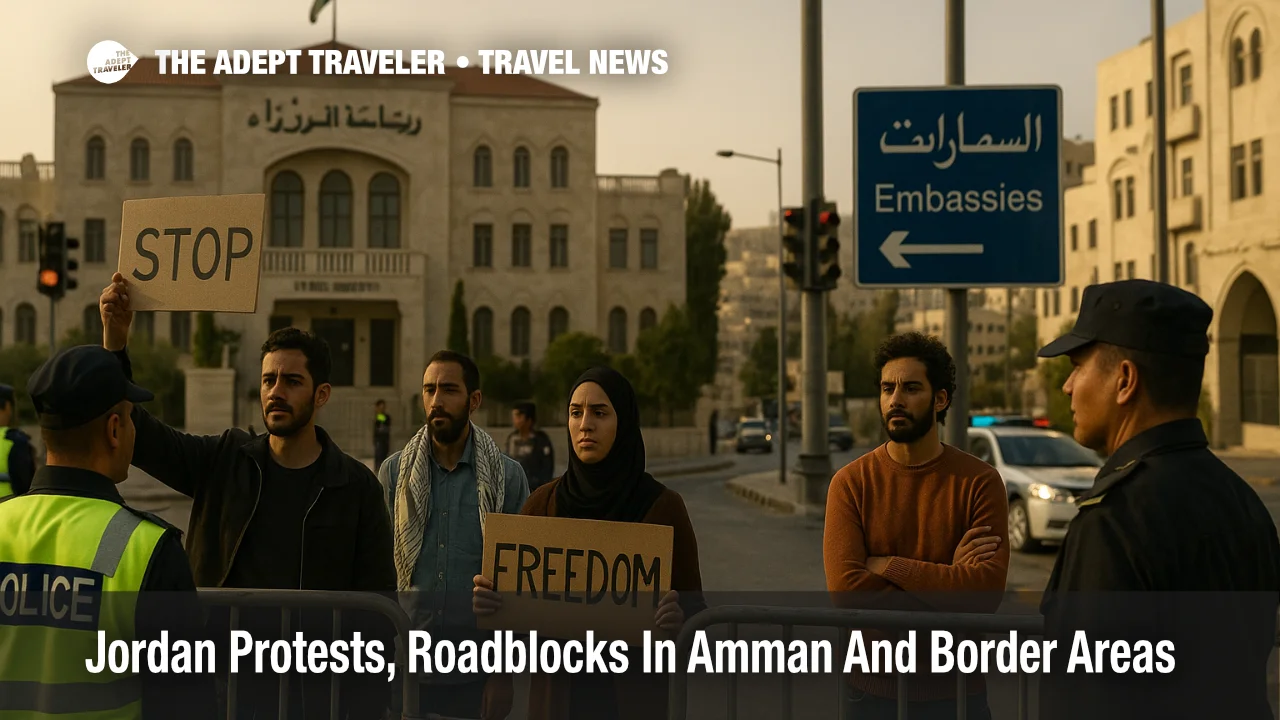Jordan Protests, Roadblocks In Amman And Border Areas

Key points
- Demonstrations in Amman often peak on Thursday evenings and after Friday noon prayers, prompting rolling road closures
- Authorities may stage checkpoints on main routes, including segments of the Dead Sea Highway and approaches to border areas
- Plan extra time for airport transfers to and from Queen Alia International Airport, and avoid protest focal points
- Security advisories urge travelers to avoid gatherings, monitor local media, and follow police instructions
Impact
- Airport Transfers
- Build larger buffers for trips to or from Queen Alia International Airport
- Route Planning
- Use alternate routes that avoid downtown protest corridors and the Dead Sea Highway when closures are reported
- Border Areas
- Expect tighter screening and intermittent closures near crossings toward the Jordan Valley and Syria
- On-The-Ground Moves
- Avoid demonstration areas, heed police cordons, and keep hotel ID and booking confirmations handy
- Day-Of Checks
- Confirm road status with hotel concierges, licensed drivers, or official channels before departing
Protests in Jordan regularly concentrate in Amman, especially on Thursday evenings and after Friday noon prayers. When turnout rises, authorities implement rolling roadblocks and crowd control around government buildings, embassy districts, and central mosques. Travelers can encounter checkpoints on major approaches, including segments of the Dead Sea Highway, and sporadic closures on roads leading toward border areas. The operational takeaway is simple. Build extra time into airport transfers, avoid demonstration areas, and follow police instructions.
Amman and transfer pinch points
In Amman, demonstrations often gather near the Prime Ministry around the Fourth Circle, at Abdoun Bridge, and around Al Husseini Mosque downtown. These locations sit on or near key arteries that connect neighborhoods to the Airport Road, so short-notice closures can ripple into long delays. The Government of the United Kingdom and Canada both caution that protests are usually peaceful but can become confrontational, and that roadblocks do occur. Their guidance is to avoid gatherings, monitor local news, and follow directions from the Public Security Directorate. That advice aligns with U.S. State Department guidance to avoid demonstrations and adjust plans based on new information.
Dead Sea Highway and border-area effects
Closures and checkpoints have been reported along the Dead Sea corridor during larger mobilizations, particularly when protests move toward the Jordan Valley. Local outlets documented police staging on roads leading to the Dead Sea to manage anticipated protests, and authorities have periodically emphasized that official road status updates should be taken from government channels, not rumor mills. Travelers driving Highway 65 should expect visible policing, occasional checkpoints, and congestion when demonstrations are announced for the valley. If you must transit during one of these windows, use licensed drivers who track official bulletins in real time.
Latest developments
Regional tensions have fueled recurring demonstrations over the last two years. Large turnouts have clustered on Thursdays and Fridays in Amman near the Israeli embassy area and central mosques, with Reuters and other outlets recording crowd control measures and temporary traffic restrictions during peak periods. Australia's Smartraveller and New Zealand's SafeTravel both note that Friday protests often result in road closures.
Analysis
For travelers, the pattern matters more than any single event. Crowd sizes and police posture tend to rise after Friday noon prayers, and there is a smaller Thursday evening wave when momentum builds during the week. That rhythm means the probability of disruption is highest late Thursday through Friday evening in downtown Amman, along protest routes to the Prime Ministry and embassy districts, and on roads feeding toward the Jordan Valley. The effect on air travel is indirect. Flights generally operate normally, but the risk of missing a departure rises if your transfer intersects a closure.
Background Why Thursdays and Fridays. In Jordan, civil society activity often organizes around end-of-week schedules. Mosques and central squares are natural assembly points after Friday prayers, and downtown corridors become focal routes, which is why police use rolling roadblocks and checkpoints to channel movement. Multiple allied governments advise the same practical steps, namely, avoidance of gatherings, route flexibility, and compliance with instructions from security services.
Final thoughts
Jordan remains a popular destination with functioning transport links. If your plans include Amman on a Thursday or Friday, build a generous transfer buffer, prebook licensed transport, and route around expected protest corridors. If demonstrations extend toward the Dead Sea Highway or border approaches, wait for an official all-clear before setting out. The goal is not to cancel trips, it is to travel with eyes open and a flexible plan.
Sources
- Jordan International Travel Information
- Jordan Travel Advisory
- Jordan Travel Advice
- Safety and Security, Jordan
- Travel Advice and Advisories for Jordan
- Jordan Travel Advice & Safety
- Jordan
- Security measures implemented ahead of protest in Jordan Valley
- Police Say All Roads Open, Urge Public To Ignore Rumors
